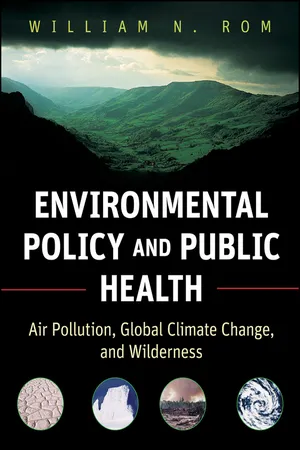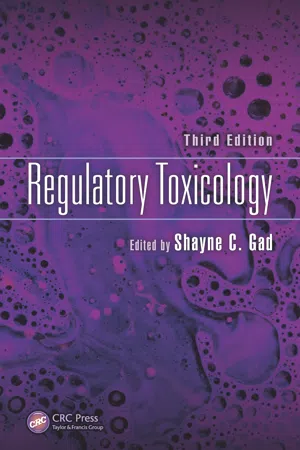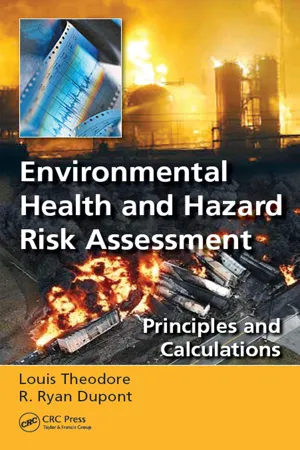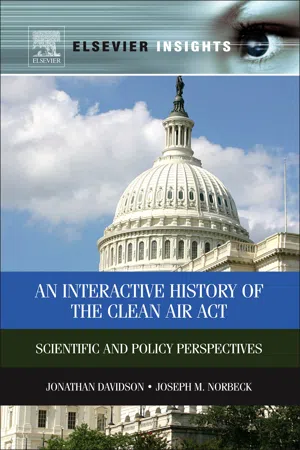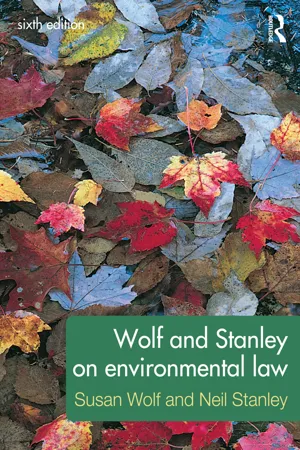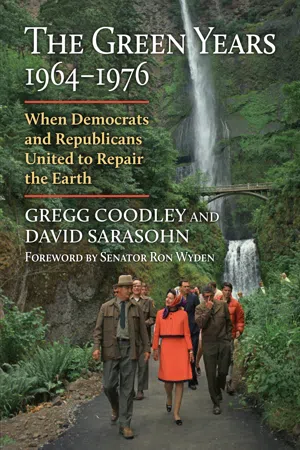Law
Clean Air Act
The Clean Air Act is a comprehensive federal law in the United States aimed at regulating air pollution. It sets standards for air quality, limits emissions of pollutants from industrial sources and vehicles, and establishes programs to address acid rain, ozone depletion, and other air pollution issues. The Act has been amended several times to strengthen its provisions and address emerging environmental challenges.
Written by Perlego with AI-assistance
6 Key excerpts on "Clean Air Act"
Learn about this page
Index pages curate the most relevant extracts from our library of academic textbooks. They’ve been created using an in-house natural language model (NLM), each adding context and meaning to key research topics.
- eBook - ePub
Environmental Policy and Public Health
Air Pollution, Global Climate Change, and Wilderness
- William N. Rom(Author)
- 2011(Publication Date)
- Jossey-Bass(Publisher)
Chapter 1 The Clean Air Act and the National Environmental Policy ActLearning Objectives
- To understand the history and importance of the Clean Air Act
- To become familiar with the National Ambient Air Quality Standards and how they are created
- To know the requirements of State Implementation Plans
- To understand which air pollutants are hazardous
- To comprehend efforts to protect vital environmental areas and to regulate new sources of pollution
The Clean Air Act is the basic law that frames U.S. environmental policy. This law has seen many versions, beginning in the 1950s with the U.S. Public Health Service (PHS) investigation of the Donora, Pennsylvania, air pollution episode. This investigation found that air pollutants from industrial sources became particularly noxious in a cold air inversion, leading to several dozen deaths directly related to the air pollution. The U.S. PHS investigators related deaths both temporally and etiologically to the air pollution, since most were cardiopulmonary deaths among the elderly. The first air pollution laws primarily funded research for health studies but gradually gave way to federal regulatory efforts that encompassed a unique brand of federalism whereby the states were mandated to carry out the federal regulations in a somewhat cooperative manner. The power to regulate interstate commerce gave the federal government its constitutional mandate, which has been consistently upheld in the courts after industry challenge.The Clean Air Act
The London Fog and the Donora Fog
The Clean Air Act (CAA), first passed in 1970, is a landmark public law born from public pressure to control smog and air pollution in general. Prior to its enactment, the world experienced some major catastrophic episodes brought about by smog. In particular, the London Fog episode in 1952, which killed thousands of people from cardiovascular and pulmonary complications, was due to cold air inversions that increased atmospheric sulfur dioxide, SO2 and particulate matter (PM). This disaster was preceded by the 1948 Donora, Pennsylvania, air pollution episode (the Donora Fog) in which high concentrations of sulfur dioxide, coupled with a temperature inversion and foggy weather, caused twenty people to die due to cardiac and respiratory disease and about half of the town's 12,000 residents to complain of cough, respiratory tract irritation, chest pain, headaches, nausea, and vomiting.1 - eBook - ePub
- Shayne C. Gad(Author)
- 2018(Publication Date)
- CRC Press(Publisher)
Such events alerted citizens and officials about the danger that air pollution poses to public health and pushed Congress to establish and continually update the current regulations for controlling air pollution. In the United States, the original Clean Air Act (CAA) of 1963 was established to clean up air pollution and provide funds for research. However, even with the passing of the CAA, the federal government did not have a concrete plan to tackle air pollution and therefore, in 1970, Congress passed a much stronger CAA. In 1970, Congress also formed the US Environmental Protection Agency (EPA), giving the EPA the primary role to carry out environmental regulations. Since then, in 1977 and 1990, the EPA has made major revisions to the CAA to improve its effectiveness and to target newly recognized air pollution problems, such as acid rain and damage to the stratospheric ozone layer. The 1990 revision also gave more authority to the EPA for implementing and enforcing regulations for reducing air pollutant emissions, and emphasized more cost-effective approaches to reduce air pollution.The CAA, like other laws enacted by Congress, was incorporated into the United States Code as Title 42, Chapter 85. The current version of the US code that includes the CAA changes enacted since 1990 is maintained by the House of Representatives.Clean Air Act• Title: Clean Air Act (CAA, 1963)• Agency: EPA• Year passed: 1963; amended 1970, 1974, 1977, 1978, 1980, 1981, 1982, 1983, 1990, and 1997• Groups regulated: State and local governments, individuals, businesses, and non-profitsSYNOPSIS OF LAWThe CAA requires the EPA to establish and update National Ambient Air Quality Standards (NAAQS) for six common pollutants found throughout the United States (Table 12.2 ). These criteria pollutants are particulate matter (PM), photo-chemicals and ground-level ozone, carbon monoxide (CO), sulfur oxides (SOx ), nitrogen oxides (NOx - eBook - ePub
Environmental Health and Hazard Risk Assessment
Principles and Calculations
- Louis Theodore, R. Ryan Dupont(Authors)
- 2017(Publication Date)
- CRC Press(Publisher)
The Clean Air Act (CAA) defines the national policy for air pollution abatement and control in the United States. It establishes goals for protecting health and natural resources and delineates what is expected of federal, state, and local governments to achieve those goals. The CAA, which was initially enacted as the Air Pollution Control Act of 1955, has undergone several revisions over the years to meet the ever-changing needs and conditions of the nation’s air quality. On November 15, 1990, the president signed the most recent amendments to the CAA, referred to as the 1990 Clean Air Act Amendments. Embodied in these amendments were several progressive and creative new themes deemed appropriate for effectively achieving air quality goals and for reforming the air quality control regulatory process. Specifically, the amendments1. Encouraged the use of market-based principles and other innovative approaches similar to performance-based standards, plus emission banking and trading 2. Promoted the use of clean, low-sulfur coal and natural gas, as well as innovative technologies to clean high-sulfur coal through provisions in the Acid Rain Program 3. Reduced energy waste and created enough of a market for clean fuels derived from grain and natural gas to cut dependency on oil imports by 1 million barrels per day4. Promoted energy conservation through provisions of the Acid Rain Program that gave utilities flexibility to obtain needed emission reductions through programs that encouraged customers to conserve energySeveral of the key provisions of the act are reviewed below. 5.10.1 Provisions for Attainment and Maintenance of National Ambient Air Quality StandardsAlthough the CAA brought about significant improvements in the nation’s air quality, urban air pollution problems of ozone (smog), carbon monoxide (CO), and particulate matter (PM) persist. In 1995, approximately 70 million U.S. residents were still living in counties with ozone levels exceeding the EPA’s current ozone standard.The CAA, as amended in 1990, established a more balanced strategy for the nation to address the problem of urban smog. Overall, the amendments revealed the Congress’s high expectations of the states and the federal government. While it gave states more time to meet air quality standards (up to 20 years for ozone in Los Angeles), it also required states to make constant progress in reducing emissions. It required the federal government to reduce emissions from cars, trucks, and buses; from consumer products such as hair spray and window-washing compounds; and from ships and barges during loading and unloading of petroleum products. The federal government also developed the technical guidance that states need to control stationary sources. - eBook - ePub
An Interactive History of the Clean Air Act
Scientific and Policy Perspectives
- Jonathan M Davidson, Joseph M Norbeck(Authors)
- 2011(Publication Date)
- Elsevier(Publisher)
Congressional disappointment with earlier permissive approaches led to enactment of the Clean Air Act Amendments of 1970. This law mandated the establishment of national quality standards to be implemented by states subject to federal certification. Supplemental amendments in 1990 specified 182 toxic pollutants to be regulated through a national permit program administered at the state level. Each stage brought forward the dynamics between scientific research and policy intervention.KeywordsAir Pollution Control Act of 1955; Air Quality Act of 1967; attainment area; best available control technology; Clean Air Act Amendments of 1970; Clean Air Act Amendments of 1977; Clean Air Act Amendments of 1990; Clean Air Act of 1963; Donora, Pennsylvania; emission controls; litigation; London fog; Los Angeles; lowest achievable emission rate; mobile source; Motor Vehicle Air Pollution Act of 1965; National Emission Standards for Hazardous Air Pollutants; nonattainment area; public health; public welfare; stationary source; toxic air pollutantsThe Clean Air Act amendments of 1970 (also referred to as “The Clean Air Act”) dramatically reframed national, state, and industry relationships. Within months of enactment, the newly formed EPA designated permissible ambient air concentrations for six pollutants based on health impact studies. The agency followed by directing states to prepare implementation plans that would meet quality standards for carbon monoxide, ozone, lead, nitrogen oxides, particulate matter, and for sulfur dioxide. Operators of major source emitters would be required to meet control standards without regard for costs or currently available technologies.Amendments in 1990 added a national permit program for toxic air pollutants to be administered and financed by state regulators. Ongoing state and industry initiatives have triggered Congressional debate over appropriate implementation strategies. The following sections focus on the adaptations by government administrators, and by industries with their respective trade associations, in relation to federal Clean Air Act legislation. - eBook - ePub
- Susan Wolf, Neil Stanley(Authors)
- 2013(Publication Date)
- Routledge(Publisher)
Usually, it will be the district council or the London borough council that exercises these powers. Chapter 6 examines the IPPC regime in regard to which local authorities are responsible for regulating Part A(2) installations with regard to all environmental impacts and Part B installations with regard to atmospheric emissions only. 8.8 The Clean Air Act (CAA 1993) Whilst the first legislative controls over atmospheric emissions date back to the Alkali Act 1863, nevertheless, this early legislation did not control the emissions of smoke from all industrial processes. The use of coal and the consequent emissions of smoke and grit particles from both houses and factories resulted in serious pollution and health problems. However, it was not until the Clean Air Acts of 1956 and 1968 that there was any comprehensive attempt to control emissions of smoke, dust and grit from industrial and domestic premises. 48 The CAA 1956 was introduced to prohibit the emission of dark smoke from any domestic or industrial chimney. A chimney was defined as any structure or opening through which smoke is emitted. Its scope was extended by the CAA 1968 which prohibited emissions of dark smoke from any industrial or trade premises, even though the emission was not made from a chimney. These Acts have now been consolidated into the CAA 1993. Enforcement of the CAA 1993 is the responsibility of the local authorities, which may act both with regard to smoke arising within their areas or affecting their areas - eBook - ePub
The Green Years, 1964-1976
When Democrats and Republicans United to Repair the Earth
- Gregg Coodley, David Sarasohn(Authors)
- 2021(Publication Date)
- University Press of Kansas(Publisher)
In January 1967 Johnson proposed strengthening the law, saying, “The situation does not exist because it was inevitable nor because it cannot be controlled. Air pollution is the inevitable consequence of neglect.” 25 The resulting Air Quality Act of 1967 set standards for air quality rather than specific emissions requirements, and created an explicit national goal “to protect and enhance the quality of the Nation’s air resources so as to promote the public health and welfare and productive capacity of its population.” 26 Muskie won a unanimous vote in his committee and in the Senate for the measure, leading Senator John Sherman Cooper to proclaim, “I have never seen in my service in the Senate a better demonstration of the committee legislative process.” 27 The act gave the federal government authority over ambient air quality standards, as well as some authority over industrial and motor vehicle emissions. The federal government would undertake research and fund states to help them set their rules. If states failed to act, HEW could set the standards for them, and could sue states if air pollution posed “an imminent and substantial endangerment” to public health. At the signing ceremony in November, Johnson said, “I would like to begin this morning by reading you a little weather report. . . . ‘[D]irty water and black snow pour from dismal air . . . to the partial slush that waits for them below.’ Now that is not a description of Boston, Chicago, New York or even Washington D.C. It is from Dante’s ‘Inferno’. . . . But doesn’t it sound familiar? Isn’t a forecast that fits almost any large American city today?” 28 He continued, “Either we stop poisoning the air or we become a nation in gas masks.” 29 Johnson admitted that the law was not as strong as he wanted, and that “additional, bolder legislation will be needed in the years ahead.” 30 Significant weaknesses in the law soon became apparent
